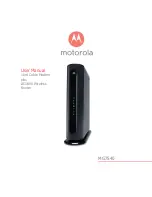
Page
38
RS
‐
232/485
RF
Modem
Product
Manual
–
MAN0782
‐
02
HV (Hardware Version) Command
<Diagnostics> HV Command is used to read the
hardware version of the modem.
ID (Modem VID) Command
<Networking & Security> ID Command is used to
set/read the VID (Vendor Identification Number)
of the modem. Modems must have matching
VIDs in order to communicate.
KY (AES Encryption Key) Command
<Networking & Security> KY Command is used to
set the 256-bit AES (Advanced Encryption
Standard) key for encryption/decryption of data.
Once set, the key cannot be read out of the
modem by any means. The entire payload of the
packet is encrypted using the key and the CRC is
computed across the ciphertext. When encryption
is turned on, each packet carries an additional 16
bytes to convey the random CBC Initialization Vector (IV) to the receiver(s).
A modem with the wrong key (or no key) will still receive encrypted data, but the resultant data
driven out the serial port will be meaningless. Likewise, a modem with a key will still receive
unencrypted data sent from a modem without a key, but the output will be meaningless.
Because CBC mode is utilized, repetitive data appears different in different transmissions due to
the randomly-generated IV.
LH (Wake-up Initializer Timer) Command
<Sleep (Low Power)> LH Command is used to
set/read the duration of time for which the wake-
up initializer is sent. When receiving modems are
put into Cyclic Sleep Mode, they power-down
after a period of inactivity [specified by ST (Time
before Sleep) Command] and will periodically
awaken and listen for transmitted data. In order
for the receiving modems to remain awake, they
must detect ~35ms of the wake-up initializer.
LH Command must be used whenever a receiver
is operating in Cyclic Sleep Mode. This lengthens the Wake-up Initializer to a specific amount of
time (in tenths of a second). The Wake-up Initializer Time must be longer than the cyclic sleep
time that is determined by SM (Sleep Mode) Command. If the wake-up initializer time were less
than the Cyclic Sleep interval, the connection would be at risk of missing the wake-up initializer
transmission.
Refer to Figures 4.3 & 4.4 of the SM Command description to view diagrams of correct and
incorrect configurations. The images help visualize the importance that the value of LH be greater
than the value of SM.
AT Command: ATHV
Parameter Range (read-only): 0 – 0xFFFF
Default Parameter Value: 0x14FF (5375d)
Number of bytes returned: 2
AT Command: ATID
Binary Command: 0x27 (39 decimal)
Parameter Range:
0 – 0x7FFF (user-settable)
0x8000 – 0xFFFF (factory-set)
Default Parameter Value: 0x3332 (13106d)
Number of bytes returned: 2
AT Command: ATKY
Binary Command: 0x3C (60 decimal)
Parameter Range:
0 – (any other 64-digit hex valid key)
Default Parameter Value: 0 (disabled)
Number of bytes returned: 2
Number Base: Always Hexadecimal
AT Command: ATLH
Binary Command: 0x0C (12 decimal)
Parameter Range: 0 – 0xFF
[x
100
milliseconds]
Default Parameter Value: 1
Number of bytes returned: 1
Related Commands: HT (Time before Wake-up
Initializer), SM (Sleep Mode), ST (Time before
Sleep)
















































